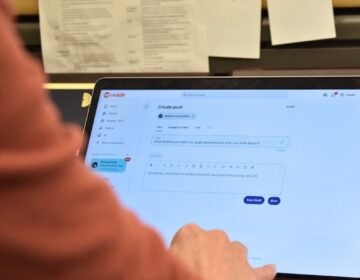2015 astronomy & space exploration highlights
ListenSpaceX ISS resupply launch could come as early as tomorrow or Wednesday. Dawn at Ceres – March 6th: orbited Vesta for a year. One-year ISS space mission for two astronauts starts March 27th. Great planetary observing – Jupiter/Venus dance together twice, late June and late October. Moon skips through too in late June and Mars joins the pair with Mercury nearby in pre-dawn Oct. New Horizons flyby at Pluto – July 14th, then on to targets in the Kuiper Belt – new planets! September 28th total lunar is completely visible to us, the moon sets shortly after the eclipse begins.
January 5, 2015
[Dave Heller] It’s time to take out the 2015 calendar and circle dates of note with Derrick Pitts, chief astronomer at the Franklin Institute. Derrick, happy new year and it won’t be long before we start circling dates.
[Derrick Pitts] Thank you very much, Dave, and happy new year to you, too. In fact, we can begin circling tomorrow as the first date in which something very interesting for this year is expected to happen. The private launch corporation SpaceX is planning to launch another resupply mission to International Space Station. Now for SpaceX, this is not an unusual thing. I think this is either their third or fourth resupply mission successful. They have had no failures so far. But they’re going to do something really interesting with their launch — either tomorrow or if tomorrow doesn’t work, Wednesday — and the plan is that their first stage booster, they’re going to try to soft land their first stage booster onto a robotically-controlled barge out in the Atlantic ocean. Now after the launch vehicle has extended all the fuel and done its job, that first stage booster, rather than just dropping it down into the ocean using parachutes, they’re actually going to try to do a controlled landing of that on this robotically-controlled barge.
I forget — is SpaceX a subsidiary of FedEx, or the other way around?
You know, it’s beginning to turn into that actually because SpaceX has been doing a very, very fine job of delivering supplies up to International Space Station. One of those things that NASA has really begun to outsource so they can move onto working on bigger stuff. But SpaceX has added this to its plans so that in the future it will no longer have to drop the boosters into the ocean, but actually bring them back and soft-land them on land somewhere where they’re much easier to retrieve and then can be re-used.
-

A Falcon 9 SpaceX rocket lifts off from Launch Complex 40 at the Cape Canaveral Air Force Station in Cape Canaveral, Fla., Tuesday, Dec. 3, 2013. The rocket is carrying its first commercial payload, a communications satellite. (AP Photo/John Raoux)
We have a month or two to get frivolity out of the way, and by March it’ll be time to get more serious.
It’s actually March 6 that we get serious about a spacecraft called Dawn arriving at the asteroid Ceres. Ceres is one of the largest asteroids known, and on March 6 the Dawn spacecraft will arrive for orbit around Ceres and do a very, very in depth study of the asteroid. It’s not the first time something like this has happened. Actually, Dawn itself has orbited Vesta (the asteroid Vesta) for nearly a year from 2011 into mid-summer of 2012. So in its grand tour out in space, the Dawn spacecraft will be able to gather all of this wonderful information about these two objects, helping us better understand their origin and the origin of planets in our solar system because of how we view Vesta and Ceres and their roles in the development of planets in the solar system.
Is there thought to be much variation among different asteroids, or are they all pretty much from the same source?
Well that’s a really great question. Some asteroids are thought to be the remnants of planets that used to exist in the solar system very, very early on. So when we look at some of them, we recognize their composition is that of the inner core of a planet. Other pieces of debris that we find flying around in the solar system may not be from the inner core of the planets and other kinds of detritus, so by looking at these asteroids in particular up close, we’re better able to identify where the asteroids originate from and what role those parts and pieces may have played in the original history and dynamics of the solar system.
Looks like later in March a pair of astronauts are booking a fairly long trip.
Yes indeed. Two astronauts — one Russian, one American — are going to be part of an experiment in which these two actually spend an entire year on board International Space Station. Now typically astronauts spend between 3 and 6 months at International Space Station, but in an effort to get more data points about how the space environment effects humans actually living and working in space, they’re going to spend a year. The data points that will be collected on this mission also will go into the collection of data points we already have that help us better understand how the human body reacts to the space environment.
Isn’t it great to note that the U.S. and Russia can collaborate at least in this regard?
Yeah, and this has been going on for quite some time in that the Russians and the Americans — of course, major partners in International Space Station — continue to work together. And that’s going to go on for some time. We all already know that the Americans and the Russians are committed to working together at International Space Station, certainly through the early 2020’s and possibly as far on as 2025.
-

The International Space Station from above. Credit: STS-114 Crew, NASA.
So what’s happening in the summer?
As it turns out, there’s some really great planetary observing that is happening this year, and most of it happens through the best part of the year when the weather’s really warm. So we can see already that Venus is rising in the evening sky. Jupiter is rising over on the eastern side of the sky not long after sunset. What will happen over the next five months is that these two will come together over in the western sky, the southwestern portion of the sky. And Jupiter and Venus will come together late in June and be very, very close to each other. But that happens twice this year. Once it happens in the evening sky — that’s in late June, right around June 30 when the two will be very close together — and then they come together as a pair again in October, but it’s in the predawn sky August 26. So for those that love to do the viewing in the evening sky will have a pairing, those that like to do the morning sky will have a pairing later in the year. And this is a really great opportunity for sky viewers to actually take note of both and see both, spread widely apart enough that there’ll be plenty of opportunity to see how the two planets move closer together over the weeks that precede it, and then away, both in June and in October.
And in July a spacecraft is heading toward the outer edges of our solar system.
You know, for the last ten years people have been anticipating this fly-by. It is the New Horizon spacecraft that left Earth ten years ago, headed out toward the dwarf planet, Pluto. Now the New Horizon spacecraft is not actually going to dwell at Pluto, it’s going to do a close fly-by and gather an incredible amount of information, far more information than we’ve ever had before about the dwarf planet and its family of moons. I think most people have missed the fact that Pluto has five moons now, five identified moons. But all the information that’s gathered and all the questions we ask about whether or not Pluto is a dwarf planet or a real planet, an actual planet, those questions will also have to be applied to a number of objects out beyond Pluto in the Kuiper Belt. Out there in that region, scientists speculate that there are quite a number of objects of really significant size that we’ve not been able to identify or see before. So New Horizons is really going to help us better understand how we go about classifying both objects like Pluto, and objects that we might find out in the Kuiper Belt.
As we move on to fall, apparently there’s an opportunity to see an eclipse, if the clouds cooperate.
Yes, there are actually a number of eclipses this year. There are four: 2 solar and 2 lunar. However, none of the solars are available to us. One of them is in the extreme north Atlantic ocean, the other is in the extreme south Indian ocean. One of the lunar eclipses, one of the lunar ones in April, won’t be available to us — it’s on the other side of the planet. We actually see it as the moon is setting in the very early morning. But the last one of the year, on September 28 will be completely visible to us. So we can look forward to seeing that as long as the weather holds for us.
WHYY is your source for fact-based, in-depth journalism and information. As a nonprofit organization, we rely on financial support from readers like you. Please give today.





